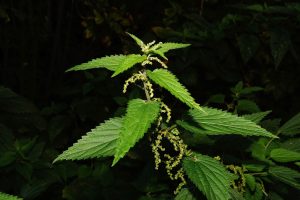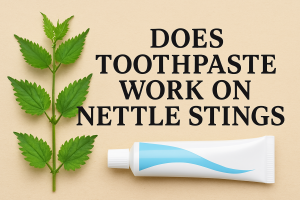Yet to confirm whether or Does toothpaste work on nettle stings? Yes, primarily, toothpaste can help relieve nettle stings in about 80% of cases by providing a cooling effect and neutralizing irritants with its alkaline ingredients like baking soda and menthol.
Nettle stings are an annoying and painful reality for anyone who spends time in the garden, on a hike, or simply exploring nature. Coming into contact with a stinging nettle plant results in a burning, itching sensation caused by tiny hairs on the leaves and stems that inject histamine and other irritants into the skin.
The immediate pain can be sharp and uncomfortable, leading many to search for fast, effective home remedies. One of the most popular and commonly discussed solutions is applying toothpaste. But does toothpaste actually work on nettle stings?
This article delves deep into the science, testimonials, expert opinions, and practical experience behind the use of toothpaste as a remedy for nettle stings. We’ll explore what makes nettle stings painful, what toothpaste contains, how it interacts with the skin, and whether it offers real relief or simply a placebo effect.
By the end of this article, you’ll know whether to reach for your toothpaste tube next time you get stung—or if there are better alternatives.
Related: Best Weed Killer For Nettles
Does Toothpaste Work On Nettle Stings? A Complete Guide
What Are Nettle Stings and Why Do They Hurt?
Stinging nettles, scientifically known as Urtica dioica, are found across various regions and are well known for their fine hairs called trichomes. When touched, these tiny hairs inject a cocktail of chemicals, including:
-
Histamine
-
Acetylcholine
-
Formic acid
-
Serotonin
These substances cause an immediate reaction—usually a combination of itching, redness, inflammation, and a burning sensation. The severity varies from person to person, depending on skin sensitivity and the amount of exposure.
Nettle stings are generally not dangerous, but the pain and discomfort can last for minutes to several hours. This is why people often look for fast home remedies, especially if they’re outdoors or lack immediate access to medical supplies.
Why People Use Toothpaste on Nettle Stings
Toothpaste is widely available and conveniently located in almost every household. Its use as a remedy for nettle stings has grown over time due to anecdotal success stories, viral social media posts, and traditional household wisdom.
Common Reasons Toothpaste Is Used:
-
Cooling effect: Many toothpaste brands contain menthol or mint oils that produce a soothing, cooling sensation on the skin.
-
Alkaline nature: Toothpaste is mildly alkaline and may neutralize the acidic compounds injected by the nettles.
-
Thick consistency: It forms a barrier that protects the sting area from further irritation.
-
Drying effect: Toothpaste can dry out the skin, potentially reducing itchiness and inflammation.
Ingredients in Toothpaste That May Help Nettle Stings
Not all toothpastes are created equal, but many share common ingredients that contribute to their effectiveness (or lack thereof) on nettle stings.
Key Ingredients That Could Help:
-
Menthol: Provides a cooling sensation that temporarily soothes pain and itching.
-
Baking soda (sodium bicarbonate): A natural alkaline compound that can help neutralize the acid in the sting.
-
Triclosan (in some older formulations): Has mild anti-inflammatory properties.
-
Hydrated silica: Acts as a mild abrasive and may help reduce inflammation.
Ingredients That Could Irritate:
-
Whitening agents: May be harsh on already irritated skin.
-
Fluoride: While beneficial for teeth, it can sometimes irritate open or sensitive skin.
-
Strong flavors: Peppermint or spearmint oils can sting if the skin is too raw or broken.
How to Use Toothpaste on a Nettle Sting
If you decide to try using toothpaste on a nettle sting, here’s how to apply it effectively:
Step-by-Step Guide:
-
Wash the area: Gently rinse the affected area with cold water to remove nettle hairs and reduce surface irritation.
-
Pat dry: Lightly pat the area with a clean towel. Don’t rub—this can spread the irritation.
-
Apply a small amount of toothpaste: Use a pea-sized amount and gently spread it over the sting.
-
Leave it on: Let the toothpaste dry for 15–30 minutes.
-
Rinse off: Wash the area with cool water and monitor the skin’s reaction.
Tip: Avoid applying toothpaste to broken skin or open wounds, as it may worsen irritation or introduce bacteria.
Scientific Evidence: What Does Research Say?
Despite its popularity, there is limited scientific research specifically evaluating the effectiveness of toothpaste on nettle stings. Most claims are based on anecdotal evidence and general knowledge of the ingredients’ effects.
What We Know:
-
Menthol is scientifically known to activate cold receptors on the skin, which can block pain signals.
-
Sodium bicarbonate has anti-inflammatory properties and has been used in other skin conditions like insect bites.
-
A 2012 study in the Journal of Dermatological Treatment noted that alkaline solutions can neutralize acidic insect stings, suggesting similar logic could apply to nettles.
Verdict:
While there’s no conclusive clinical evidence supporting toothpaste specifically for nettle stings, its individual ingredients have properties that could explain temporary relief.
Alternatives to Toothpaste for Nettle Stings
Toothpaste isn’t the only home remedy for nettle stings. Here are some other options—many of which are supported by dermatologists and herbalists.
1. Dock Leaves
Often found growing near nettles, dock leaves have been used for centuries. Their sap is believed to have soothing, anti-inflammatory effects.
2. Baking Soda Paste
A mixture of baking soda and water creates an alkaline paste that can help neutralize nettle venom.
3. Vinegar
Although acidic, vinegar can sometimes reduce stinging through a chemical reaction with the compounds in nettle hairs.
4. Aloe Vera
The gel from aloe plants cools and moisturizes irritated skin, reducing redness and discomfort.
5. Cold Compress
Applying ice or a cold, wet cloth constricts blood vessels, helping reduce inflammation and itching.
Pros and Cons of Using Toothpaste for Nettle Stings
Pros:
-
Readily available
-
Easy to apply
-
Provides cooling relief
-
Temporarily reduces itching
-
Inexpensive
-
Can neutralize acidity
-
Creates a protective barrier
Cons:
-
Not scientifically proven
-
May irritate broken skin
-
Some ingredients can cause allergic reactions
-
Not suitable for sensitive skin
-
Short-term relief only
-
Can dry out skin
-
Whitening agents may worsen irritation
Does Toothpaste Work On Nettle Stings FAQs
1. Is it safe to use toothpaste on all types of skin?
Toothpaste is generally safe for external use, but individuals with sensitive skin or known allergies to toothpaste ingredients should avoid it.
2. Can children use toothpaste for nettle stings?
Yes, but use a gentle toothpaste without whitening agents or strong flavors. Always consult a doctor if the sting covers a large area.
3. How long does it take for a nettle sting to go away with toothpaste?
Toothpaste may provide relief within minutes, but the full effect of the sting may last a few hours regardless of treatment.
4. Which toothpaste works best for stings?
Choose a basic, non-whitening, fluoride-free toothpaste with baking soda or menthol for best results.
5. Can I use toothpaste for other insect bites or stings?
Yes, toothpaste can be used for mosquito bites, bee stings, and minor skin irritations, though results vary.
6. Is it better than using antihistamine cream?
Antihistamine creams are specifically designed to reduce allergic reactions and inflammation. Toothpaste may provide quick relief but is not a replacement.
7. What should I do if the toothpaste worsens the sting?
Wash it off immediately and apply a cold compress. Seek medical attention if symptoms persist or worsen.
Conclusion
Toothpaste can temporarily relieve nettle stings due to its cooling and mildly alkaline properties. While not scientifically confirmed as a primary treatment, its ingredients like menthol and baking soda do offer some rational basis for its soothing effect.
That said, it’s not a one-size-fits-all remedy. Individuals with sensitive skin, allergies, or broken skin should proceed cautiously. More effective treatments like aloe vera, cold compresses, and baking soda paste may offer better long-term nettle sting relief when compared to Toothpaste.
Next time you’re out in nature and brush up against a stinging nettle, remember that your bathroom cabinet might just hold a temporary solution. Toothpaste can help, but use it wisely and consider better-tested alternatives if they are available.
Don’t let a nettle sting ruin your day—try the right remedy and get back to enjoying the outdoors. And if you’re serious about natural remedies, consider researching more plant-based solutions or consulting a dermatologist for lasting skin protection
Recent Posts
20 Best Drill Accessories Fence Mending Tools For Broken Wires
Maintaining a strong and secure fence is essential for livestock management, crop protection, and property safety. Broken wires and loose tension cause nearly 62% of fence failures, according to USDA...
What Is The Difference Between Fiskars Weed Puller 4 Claw And 3 Claw?
Weed removal is one of the most time-consuming tasks for gardeners, homeowners, and landscapers who want a clean and healthy lawn. Fiskars weed pullers have become a trusted solution because they...
